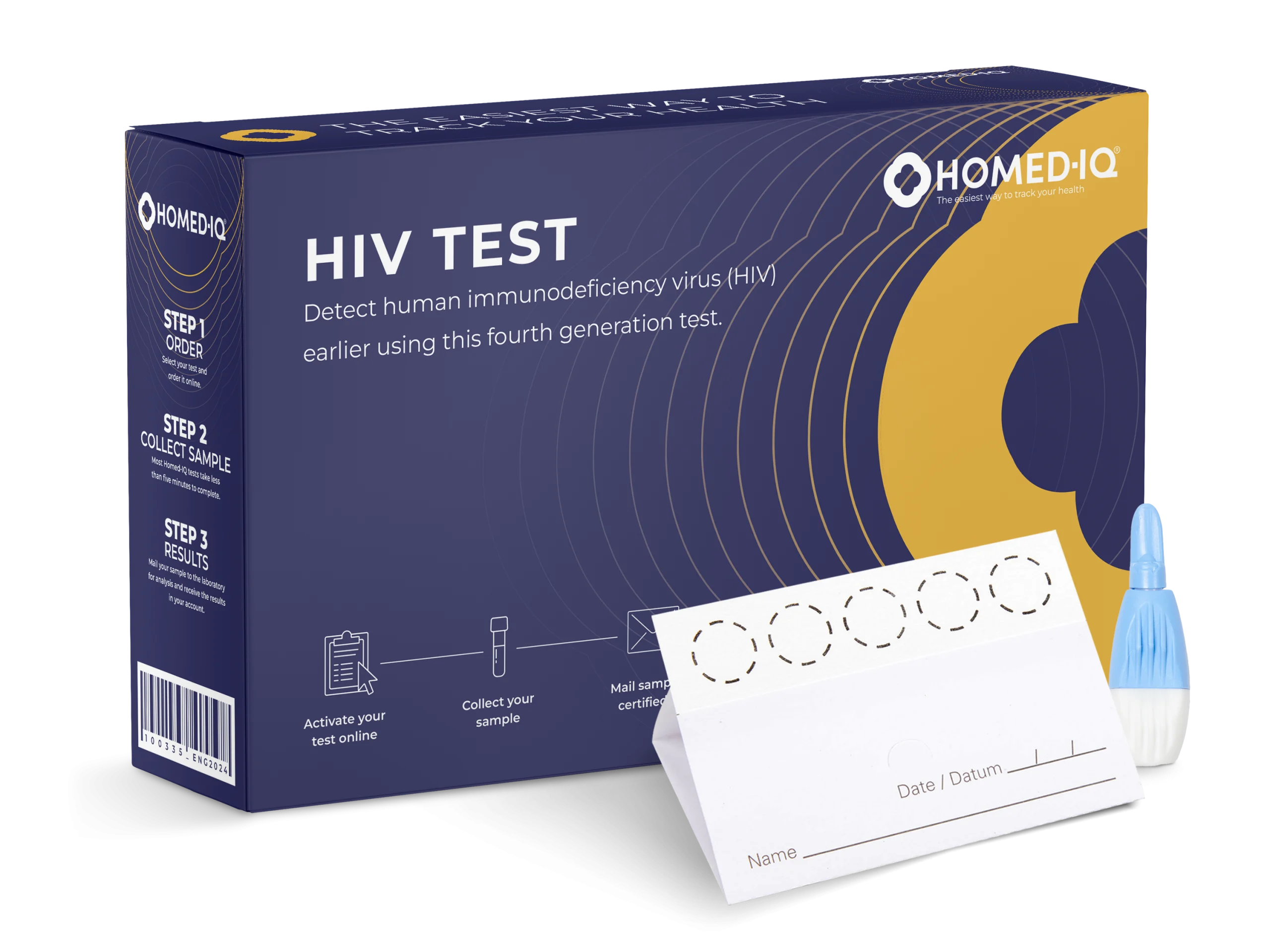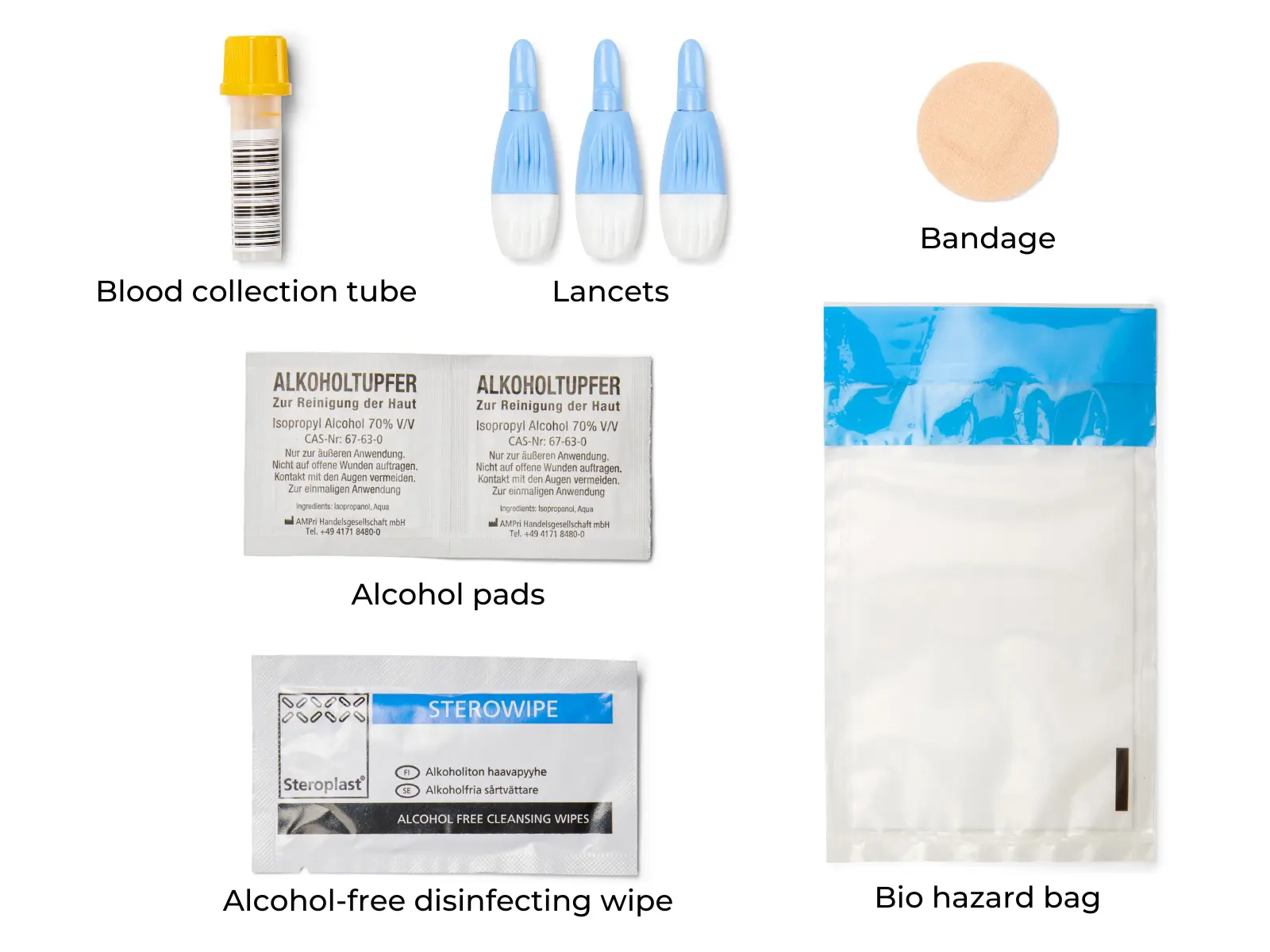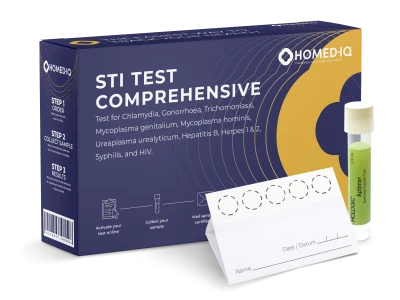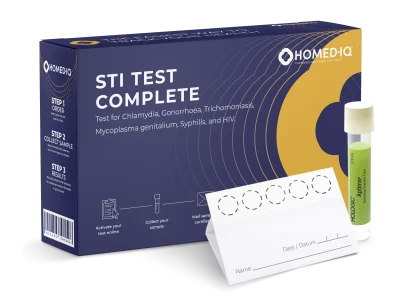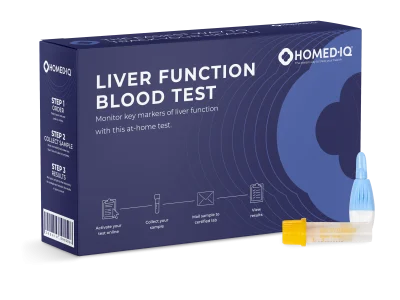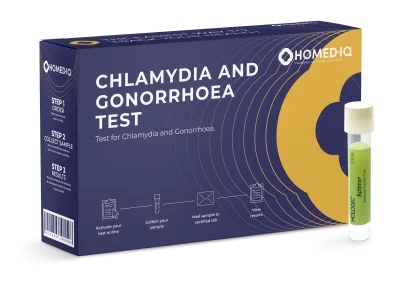

HIV Test
€45,00
Free Shipping to
Get a fast, reliable diagnosis from the privacy of home. This fourth generation laboratory test detects both HIV antibodies and the p24 antigen, allowing for an earlier diagnosis than rapid HIV tests. Simply ship your finger prick blood sample to our partner laboratory and receive certified test results in days.
Test mode:
Finger prick blood test
Window Period:
The window period is the time between when you were infected with an STI and when it is detectable with a test. The window period for HIV is 4 weeks and in rare cases up to 3 months. If the test result is negative, HIV can be reliably ruled out 3 months after sexual contact.
What do we test for?
About HIV
Human Immunodeficiency Virus (HIV) is a virus that attacks the body’s immune system. The virus is present in blood, semen, vaginal fluid, and breast milk, and can be contracted if these fluids enter your bloodstream. HIV is usually transmitted through anal or vaginal sex or sharing needles, syringes, or other drug-injection equipment. HIV often causes little to no symptoms at first, and individuals may be infected for years before developing noticeable symptoms. If HIV goes untreated for an extended period of time, the body’s immune system can decline, increasing susceptibility to many types of illnesses. This can lead to Acquired Immunodeficiency Syndrome (AIDS), a chronic and life-threatening condition. HIV can be detected with a blood test. HIV cannot be cured, but AIDS can be prevented through proper detection and treatment. Timely and intensive treatment with antiretroviral medicines can make the blood “virus-free”, so that those living with HIV are no longer contagious and have a normal life expectancy.
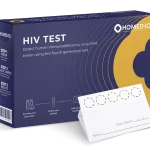
€45,00
Free Shipping to
What does the test result mean?
All Homed-IQ tests come complete with a detailed explanation of the test results and a downloadable laboratory report that can be brought to your GP if needed.
What does a negative test result mean?
A negative test result means that HIV was not found in the test material you supplied and that no treatment is required.
What does a positive test result mean?
A positive test result means that HIV has been detected and that treatment is needed. For your own health and to prevent the transmission of HIV to others, it is important that you receive treatment if you test positive.
In the case of a positive test result, you should immediately take the test results to your doctor for a second confirmatory test. If HIV is confirmed, your doctor will give you advice on how to warn your past sexual partners so they can also get tested if needed. Your doctor will discuss HIV treatment, monitor your health, and can provide information on living with HIV. With prompt diagnosis and treatment, people living with HIV can have healthy, happy lives.
How soon will I receive my test result?
Mail your test to the laboratory immediately after collecting your sample. Once the test has reached the lab, you will receive an email notification. In a few working days your test results will be available.
How are my results shared?
We understand that test results can be confusing. That’s why at Homed-IQ, we make it easy for you to interpret your results and understand what’s going on with your health.In your personal online dashboard, you can view your test results and access clear and simple explanations about the markers that were tested. All test results are verified by a Homed-IQ’s medical team before being sent to you. The results of the HIV Test are indicated with a negative or positive result.
What is the HIV Test?
Homed-IQ’s HIV Test is a fourth generation laboratory test for HIV, detecting both HIV antibodies and the p24 antigen. When your body is first infected with HIV and has not had time to create antibodies to the virus, the blood has a high level of p24. Testing for both HIV antibodies and the p24 antigen enables earlier detection of HIV infections.
How does the HIV Test work?
This is a finger prick blood test that requires a few drops of blood. You will receive detailed instructions with your test so that you can easily take your sample from home. After your sample is collected, mail the test kit to our certified laboratory with the enclosed prepaid shipping materials. You will receive the test results within a few days.
When can you test for HIV?
The window period is the time between when you were infected with an STI and when it is detectable with a test. Every STI has its own window period. If you test for an STI before the window period has passed, you may test negative even if you are infected. See below for more information about the specific window period per STI and determine when you can reliably administer this test.
What is the window period for HIV?
HIV: 4 weeks to 3 months. If the result is negative, then only reliably 3 months after sexual contact.
Source: Nederlands Huisarten Genootschap
The symptoms of HIV depend on the stage of infection.
Primary infection (Acute HIV)
Some people with HIV develop a flu-like illness 2-4 weeks after infection. This can be mistaken for a regular cold or flu or the symptoms may be so mild you do not notice them. A primary HIV infection can include symptoms of:
- Fatigue
- Fever
- Rash
- Headache
- Sore throat
- Night sweats
- Swollen lymph nodes (mainly in the neck)
After a few weeks, the symptoms of an acute HIV infection will disappear. This is followed by a clinically latent phase of infection, where HIV is still present in the body but you may experience no symptoms for months or years. Many people on treatment for HIV remain in the latent phase for a long time.
Chronic HIV infection
As the amount of HIV in the blood increases and the immune system is weakened over time, symptoms and infections may become more noticeable and can include:
- Fatigue
- Fever
- Diarrhoea
- Swollen lymph nodes
- Oral thrush (yeast infection)
- Weight loss
- Pneumonia
- Shingles (herpes zoster)
Acquired Immunodeficiency Syndrome (AIDS)
Access to antiretroviral therapy has dramatically decreased the number of people with HIV who develop AIDS. Untreated, HIV usually turns into AIDS within 8-10 years.
When AIDS occurs, the immune system is severely damaged and there is a high amount of HIV in the blood. As such, people with AIDS are more likely to get illnesses and infections that would not cause illness in a healthy immune system. These are called opportunistic infections or opportunistic cancers. Signs and symptoms of these illnesses may include:
- Sweats
- Chills
- Fever
- Skin rashes or bumps
- Weight loss
- Chronic diarrhoea
- White spots or lesions on the tongue or in the mouth
- Swollen lymph nodes
- Fatigue
What is an STI?
Sexually Transmitted Infections (STIs) are diseases that are transmitted through sexual contact. You can be infected with or pass on a virus or bacteria to someone else during sex. This can be through the penis, vagina, anus, and sometimes also with your mouth or fingers. Many STIs cause little or no symptoms. However, in some cases STIs can cause uncomfortable symptoms at the location of infection or cause long-term damage to the body if infections go untreated. While most STIs are treatable, a prompt diagnosis and treatment is important for staying healthy. It is therefore important that you get tested if you have been at risk to know your own STI status, get treatment if needed, and to prevent STI transmission to others.
HIV
Human Immunodeficiency Virus (HIV) is a virus that attacks your immune system, making you more vulnerable to invading viruses and bacteria. HIV attacks immune cells in your blood known as CD4 cells. CD4 cells help protect you against infections and illness. If your immune system is highly weakened and your CD4 cells drop to a low level, HIV can progress to acquired immunodeficiency syndrome (AIDS).
HIV is is present in blood, semen, pre-cum, vaginal fluid, rectal fluid, and breast milk. HIV can be transmitted if these fluids enter your bloodstream, such as through a small cut or tear, needle stick injury, or childbirth. HIV is most often transmitted through anal or vaginal sex or sharing needles, syringes, or other drug-injecting equipment.
You may not have many symptoms of HIV at first, and you may have the virus for years before you develop noticeable symptoms. Without treatment, however, your body’s immune system will decline, making you susceptible to many types of illnesses. This can lead to Acquired Immunodeficiency Syndrome (AIDS), a chronic and life-threatening condition if left untreated. HIV can be detected with blood tests. HIV cannot be cured, but AIDS can be prevented through proper diagnosis and treatment. Timely and intensive treatment with antiretroviral therapy can make the blood “virus-free”, so that the person living with HIV is no longer contagious and has a normal life expectancy. With proper care and treatment, people with HIV can live healthy and happy lives.
Frequently asked questions
Why do I need to activate my test kit?
What is the difference between incubation period and window period?
Can you use an HIV Test before you have symptoms?
Is this HIV Test an alternative to a test at the doctor?
Will my health insurer reimburse this HIV test?
Who is this HIV Test not suitable for?
How can I prevent HIV?
- Practice safe sex: HIV is often transmitted through sex. By practicing safe sex, you reduce your risk of HIV. Safe sex means using condoms or dental dams properly every time you have sex, including oral sex.
- Get tested for STIs regularly: The risk of HIV is higher if you have another STI. Get tested for STIs regularly to ensure no infection goes unnoticed.
- Use PrEP or PEP: PrEP and PEP are HIV inhibitors. This means that they stop HIV from infecting the body. PrEP can be used before sex to prevent a potential HIV infection. PEP can be used after a potential HIV exposure to help block the virus from infecting the body.
- Never share needles/syringes: Sharing needles is a high-risk activity that can transmit HIV. If you use injection drugs, always use a clean needle and never share your injection equipment with others.
